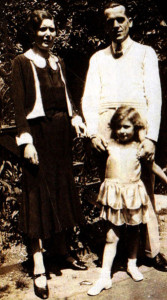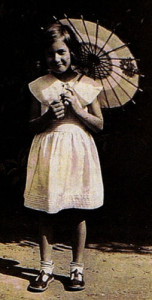
I’ve paid a deposit on a sewing I machine,” said Mum. “On the never-never?” Dad was horrified. “That means the tally man will be coming round from now ’til who knows when.” He was not best pleased.
“Well, how else am I going to get one?” Mum replied. It was 1930 and money was tight. Dad muttered something about her ‘always getting her own way’.
The machine soon had a permanent place in the home, primed and ready for action. Mum had rummaged through the remnant boxes in the drapers and the market, gathering up useful pieces of material. There was nothing haphazard in her searches; she knew how she would use each item.
When it was time to collect the divi from the Co-op, off we went to the big branch at Tooting, where she reaped rich rewards. Cotton fabrics in the sale were reduced to four pence three farthings a yard. Patterned or plain, spotted or striped, all became part of her store, along with the other essentials, buttons and buckles, trimming of lace or ric-rac braid and a rainbow collection of embroidery silks.
Running up a garment was no problem, with material spread on the kitchen table, the paper pattern pinned in place and a pair of sharp scissors, it soon began to take shape. A favourite pattern was carefully ironed and filed away for future use. Coats could be turned, faded dresses unpicked, re-styled and dyed, and hey presto, become something new.
Later they became aprons or overalls, peg bags or kettle holders. When they were eventually past any further revivals they made useful dusters and cleaning rags. I doubt if any money was wasted on buying a floor cloth when there was a bit of old vest or worn towel that would do the job.
Summer dress
When the headmistress at school initiated a summer dress for the girls. Mum came to the rescue of less talented parents, and heaps of blue and white checked

gingham occupied our house. At Christmas, with fancy dress parties in full swing, Mum would produce frocks for fairies or flower girls. Weldon’s pattern books were pored over and outfits chosen.
The introduction of clothes rationing in 1941 presented a greater challenge.
Newspapers suggested ways of transforming hubby’s trousers into a smart skirt, an operation requiring a lot of unpicking and re-stitching. Hubby might also find that his shirt tails had been cut off to make a blouse, leaving him with a chilly rear-end. Many ingenious designs were created by stitchery-witchery.
The sewing machine proved its worth many times over, just as Mum said it would. And Dad need not have worried about the tally man; he was very discreet.
Pam Buckland, Petersfield, Hampshire








